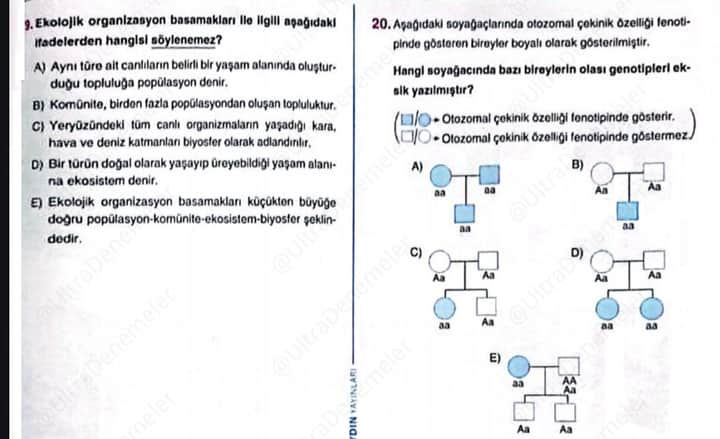What are the correct answers to questions 9 and 20 in the provided image, regarding ecological organization levels and genetic inheritance, respectively?
Answer:
Let’s address each question one by one.
Question 9: Ecological Organization Levels
The question asks which of the given statements about ecological organization levels is incorrect:
A) It states that individuals of the same species living in a specific area form a population. This is a correct statement — a population is a group of individuals of the same species living in a particular geographic area.
B) It defines a community as a collection of multiple populations. This is also correct. A community includes all the living organisms from different species that interact within a particular area.
C) It describes the entire range of living organisms in land, air, and water as the biosphere. This is a correct definition of the biosphere, which includes all ecosystems and living organisms on Earth, along with their interactions with elements of the lithosphere, hydrosphere, and atmosphere.
D) It defines an ecosystem as the area where a species lives. This is incorrect. An ecosystem includes both the biotic (living) community and the abiotic (non-living) factors they interact with in a particular area. The description here seems to confuse ecosystems with habitats.
E) It describes ecological organization levels from smallest to largest as population-community-ecosystem-biosphere. This is correct as this is generally the accepted order of ecological organization levels.
Final Answer for Question 9: D) Bir türün doğal olarak yaşamını sürdürebildiği yaşam alanına ekosistem denir. (This statement is incorrect because it confuses ecosystems with habitats.)
Question 20: Genetic Inheritance in Pedigrees
This question involves analyzing pedigrees to identify which, if any, genotypes are missing. It focuses on dominant and recessive traits, specifically those that are autosomal recessive.
In a pedigree, squares represent males, and circles represent females. Shaded symbols indicate individuals who express the recessive trait. Unshaded symbols do not express the recessive trait but could be carriers (heterozygotes) or homozygous dominant if the trait is autosomal recessive.
-
Option A:
- Both parents are heterozygous (Aa), and some offspring express the recessive trait (aa).
-
Option B:
- One parent shows the recessive trait (aa) while the other parent is heterozygous (Aa), which is correctly reflected.
-
Option C:
- Both parents are homozygous recessive (aa). It’s impossible because a trait cannot reappear in the progeny if both parents have the recessive trait.
-
Option D:
- Shaded individuals have the recessive genotype (aa), and it accurately reflects all relationships.
-
Option E:
- This arrangement matches the assumptions about inheritance properly.
Final Answer for Question 20: C) This pedigree incorrectly assumes that both parents have recessive genotypes, violating the genetic inheritance rules.
In summary, Question 9 has a descriptive error regarding ecosystems, while Question 20 contains inheritance mistakes in pedigree option C.
